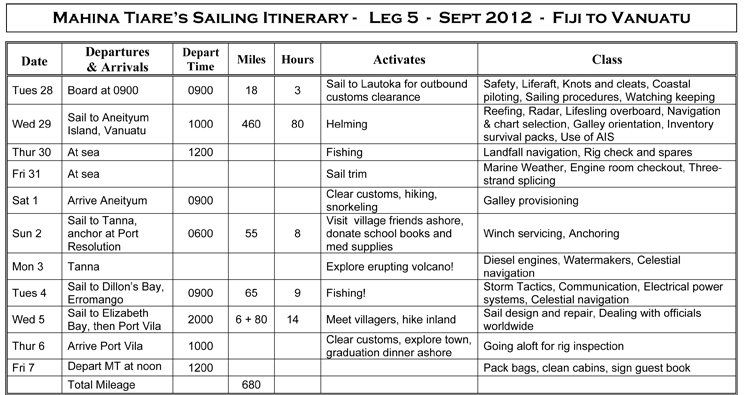Leg 5 – 2012, Update 1
September 1, 2012, 0400 hrs, 20.07 S, 170.15 E, Log: 159,030 miles
Baro: 1017.8, Cabin Temp: 76 F cockpit 73 F, sea water 77 F
Broad Reaching at 7.1 kts in 20 kt SE winds, single reef in main and geona
VANUATU ON THE RADAR!
Our time between Legs 4 & 5 was a real treat, as we were cruising in company with Robert and Lesley, Amanda’s parents. Once we’d tidied up MT and Gracias, we rented a car together and drove 4.5 hrs across Viti Levu to the capital Suva, enjoying a night ashore from where we had last anchored together six years earlier at what used to be called Tradewinds Hotel but is now Novatel. That afternoon Amanda and I did our annual massive shop at Cost U Less, an offshoot of Costco, while Robert and Lesley checked out the old Royal Suva Yacht Club. The following morning we enjoyed breakfast overlooking the moored yachts and then a quick stop for fishing lures at Amanda’s favorite shop in Suva, Bob’s Hook Line & Sinker, along with a final load at Cost U Less before heading back to the other side of the island.
The following morning we both headed out to Musket Cove on Malololailai Island where we’d gotten married on the beach 14 years ago. We enjoyed a week at the island, working on our boats during the day and frequently sharing evening meals aboard or ashore and then, all of the sudden, it was time to sail back to Vuda Point Marina and shop for fruit and veg for Leg 5.
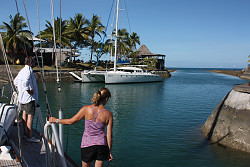
Departing Vuda Point Marina |
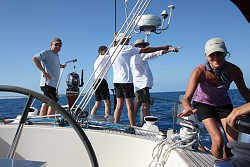 Thankfully we were soon underway with enough wind for everyone to practice Lifesling Overboard Rescue before we sailed between two famous surfing destinations, Tavarua and Namotu Islands. Both Bill and Roger are keen surfers and were checking out the waves. Thankfully we were soon underway with enough wind for everyone to practice Lifesling Overboard Rescue before we sailed between two famous surfing destinations, Tavarua and Namotu Islands. Both Bill and Roger are keen surfers and were checking out the waves. |
We had Leg 5 crew briefing and safety orientation Monday afternoon and requested they board at 9 am instead of our normal noon start time. This early start gave us time to motor six miles north to the port of Lautoka for outbound clearance. I went ashore for clearance whilst Amanda and Dave did a final provision. Thankfully clearance was a breeze with one interesting new wrinkle; an immigration officer is now required to board all departing vessels checking in every cabin and space and that all crew are accounted for. It appeared as if he was closely checking for unlisted passengers and we wondered if this had anything to do with a megayacht that was seized last week in Vanuatu.
Our first evening at sea was surprisingly calm as 15-20 kt SE tradewinds had been forecasted but before the next morning the wind returned and since then we have been rocketing along. We have passed two troughs, clearly shown on the weatherfax charts from New Zealand, each having a bit of rain and up to 29 knots of wind.
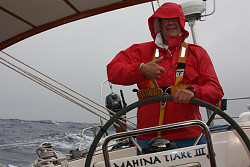
Bill enjoying his trick on the wheel…rain and all! |
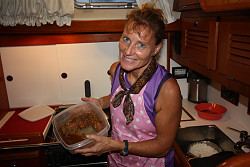 Amanda gets ready to grill our marinated catch of the day Amanda gets ready to grill our marinated catch of the day |
Swells have been minimal but from all direction and all of us except for Bill have had issues with seasickness which has fortunately passed for all but Raul and Susana. Soon after coming aboard Roger had mentioned that he hoped we’d get a bit of heavy weather sailing, so he and most of the guys were delighted when they got to tuck in first one, then two and three reefs in the main throughout the night.
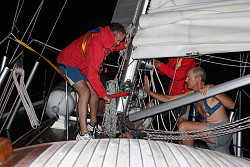 Bill and Roger tuck in third reef under John’s guidance Bill and Roger tuck in third reef under John’s guidance |
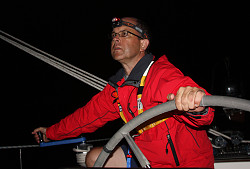 While the mainsail is reefed Joe keeps MT trimmed and on course While the mainsail is reefed Joe keeps MT trimmed and on course |
Now Aneityum, the closest Vanuatu Island to Fiji is only 18 miles away and we have kept one reef in the main and headsail so as not to make landfall before dawn.
September 2, 2012, 2210 hrs, 19.31S S, 169.29 E, Log: 159,113 miles
Baro: 1017.8, Cabin Temp: 77 F cockpit 73 F, sea water 77 F
At anchor in 20-30 kt winds, Port Resolution, Tanna Island
IT’S BLOWING A HOOLIE!
Our landfall at Aneityum (http://en.wikipedia.org/wiki/Anatom) was before breakfast and within ten minutes a fast new police skiff slowed when passing and the skipper announced he’d bring the officials over shortly. The skiff was ferrying people across the bay to the tiny, uninhabited Mystery Island (located on the south side of the reef it provides protection for the anchorage) in preparation for the arrival of the semi-weekly flight to the islets tiny grass strip.
By 0730 Richard George, the island’s police officer on loan from Port Vila, came aboard and pleasantly explained that in order to save money the government had recently requested that the policeman was to handle all inbound yacht clearance. Not only was this a Saturday, but what a change from last year when we waited all day for the dedicated quarantine and customs officers to board and clear us as they first had to process 1,200 people on a P & O cruise ship. Richard felt clearing arriving yachts quickly, even on weekends, and without overtime charges was important so crews could visit ashore. Now that’s the most cruiser-friendly viewpoint we’ve ever heard of!
Aneityum is very fortunate as about eight times a year P & O cruise ships from Australia anchor off and shuttle passengers ashore to Mystery Island for snorkeling and beach time while the islanders set up a market of arts and crafts. Richard welcomed us to snorkel off the islet but firmly asked that we not take lobster or fish as this is an important marine reserve. He (and the islanders) are quite upset that the ICA Rally members who had recently departed, had illegally collected lobsters from the posted marine reserve.
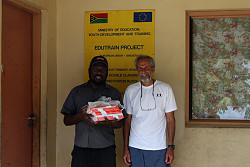 Jonathan accepting exercise books from Raul Jonathan accepting exercise books from Raul |
Once cleared in, we dinghied ashore to deliver school supplies our crew had generously purchased in Fiji. School was closed for winter holidays but we met two teachers, Jonathan and Ben of Anelcauhat Primary School (www.mysterious79.blogspot.com) directly ashore from the dinghy landing channel. They sincerely thanked us for the supplies and Jonathan said that if school was in session the kids would show demonstrate traditional dancing. He also mentioned that they would welcome further school supplies, dictionaries and primary school books for their newly-opened library. The library was established with funds donated by tourists as the school children proudly give tours of school gardens and perform traditional “kastam” dancing. We then went off on an exploration of the village and a hike along the beach and were impressed at how quiet and friendly these people are and how tidy they keep their fairly primitive homes and property.
Yesterday morning greeted us with wind and rain and we all had second thoughts about setting out on the 55 mile passage north to Tanna Island (http://en.wikipedia.org/wiki/Tanna_(island) . But when I called Robert he said they were ready to go so I dropped David, who had volunteered to give Robert and Lesley a hand for the passage, off at Gracias and they set sail. I started breakfast and we waited a bit to give Gracias a head start but we were never able to catch them.
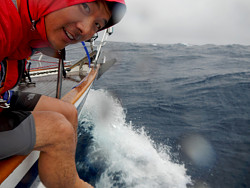 Roger enjoying the wet surfing action at the bow Roger enjoying the wet surfing action at the bow |
The weather charts showed a slow-moving trough had stalled over southern Vanuatu which was providing us with 20-35 kt winds and rain. Roger, who is such a keen surfer that he drives 2.5 hours from Portland, Oregon to surf in the frigid North Pacific waters, was whooping and hollering as he hit 12.4 kts surfing towards Tanna. We kept putting up more sail to see if anyone could beat Roger’s record (also our highest speed so far this year!) but his record still stands.
Recently in Auckland, I had recently purchased the latest British Admiralty Anchorage chart for Vanuatu, only to discover there is no longer is any chart available of Port Resolution. I had given Robert, who hadn’t been here before, an ancient WWII chart of Port Resolution as none of our electronic charts showed any depth or detail. Fortunately, two years earlier we’d recorded two sets of entrance coordinates for the bay when we were involved in a search for an overturned local boat. At that time the visibility at the entrance had been well under one mile in driving rain and rough seas with winds still gusting close to 30 knots and we knew boats returning to the anchorage after us might require additional help.
Our crew did an excellent job, safely gybing, lining up on the difficult, unmarked entrance and dropping the main just as we entered between the jaws (narrowest part) of the reef. While most of the crew were securing the main I asked Susana to perch the anchor on the bow roller so we’d be ready to anchor once we entered the rolly and shallow bay. Minutes later we heard the continual sound of the windlass quickly powering out the chain as Susana came running back saying she couldn’t stop the chain!
Raul talks about Offshore Sail Training
We were at the narrowest and most critical part of the entrance when the anchor hit the bottom stopping us instantly. Amanda quickly shut off the windlass circuit breaker under the nav seat and it became immediately obvious we were in a real pickle in only 18′ of water with violent rain gusts edging us toward the breakers. When Amanda flicked on the breaker the windlass instantly started releasing more chain. While Bill did a brilliant job of keeping the bow into the wind Roger and I manually heaved in the chain and Joe manually cranked the windlass to stow the chain below decks. Unfortunately our CQR anchor had REALLY set well so we cleated the chain off and Bill powered forward to allow us to pull in the 80′ of chain and 75 lb anchor. Needless to say it took every ounce of our strength to heave it in.
Meanwhile, David and Robert had been watching our little drama trying to figure out why in the world we would choose to anchor in such a dangerous place. Robert said, “I’ll bet John is having them practice anchoring – see here on their itinerary, it says they’re covering anchoring today!”
We used the manual clutch on the windlass to release the anchor and chain in the fairly crowded bay. We’ve only ever seen four boats in Port Resolution but now seven boats were waiting out the bad weather. Several had anchored bow and stern to counter the swell so it was a little challenging to find a safe spot. Very unusually, our anchor drug several boat lengths before we veered additional chain and it then held well, even as Bill added more reverse engine power. The minute Bill shut the engine down Roger offered to dive down and check the anchor and reported it totally buried up to the shackle. Whew! What an adventure – but it wasn’t over yet!
Minutes later, previous expedition members Jim and Katie Thomsen from their Hallberg-Rassy 40 Tenaya (www.tenayatravels.com) dinghied over. They were heading ashore to deliver a photo album Jim had compiled for a nearby village of the seven-day circumcision ceremony of five young boys that they had just attended. Their images and stories were truly like something out of National Geographic. Jim and Katie had spent one month last year, and now another month, interacting and working with several local villages, even staying ashore in a treehouse in a distant village. Jim said that they had taken and printed over 120 ID card and football card photos using a portable printer they had purchased elsewhere, and they also gave us a copy of a brochure and map they had produced for the local villages to give to the yachts. When I mentioned that we were planning on heading ashore to try and arrange transport up to the volcano for the following afternoon/evening, Katie offered to speak with the chief about it.
We then launched the dinghy, helped Gracias anchor in a more protected spot, retrieved Dave, and our gang launched into their weather and Lifesling tests as I started trying to repair the windlass. I first thought that the “down” windlass switch on the foredeck must have shorted out, so I cut the wires, pulled out the old switch, then threaded and mounted a spare switch. Unfortunately, when I turned the breaker on the windlass once again started lowering chain, so that wasn’t the problem. I now had a two hour job, after dinner, of wiring the new switch into place.
My next thought was that perhaps the windlass solenoid located next to the motor might have stuck on so I tapped it a couple times and, VOILA!!, it worked perfectly. Being paranoid about something as critical as the windlass failing we’ve long carried but never have had to install a spare solenoid. It will be a multi-hour job working in a cramped location and one which I hope will wait until the end of this expedition when we are on a mooring in Port Vila.
Whew! It’s now 0400, winds have finally dropped to 10 kts so we no longer have crew standing anchor watch. It’s still drizzling, but the forecasts show that by late afternoon, when we hope to head up the volcano, the rains should be mostly passed.
September 5, 2012, 0700 hrs, 18.44S S, 169.12 E, Log: 159,168 miles
Baro: 1019.0, Cabin Temp: 73 F cockpit 70 F, sea water 77 F
At anchor Potnavrin, Erromango Island
NON-STOP ADVENTURES!
Early yesterday morning Robert and I went ashore in drizzle and wind and spoke with brothers Stanley and Johnson, chief and yacht club organizers about arranging a ride up to Mt Yasur volcano that evening. Johnson said the village truck was enroute three hours across the island to Lenakel, the only town, and offered to call his cousin (the driver) to check on progress. It’s amazing
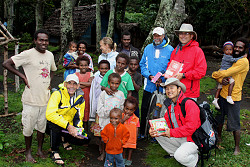 Crew and Villagers gather for a photo with donated school supplies Crew and Villagers gather for a photo with donated school supplies |
that people barely out of the Stone Age have mobile phones but the driver said the roads were terrible; however, he would try and be back by 4 PM and would try and get us up the volcano.
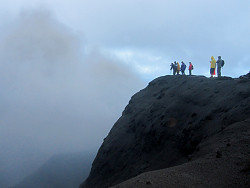 |
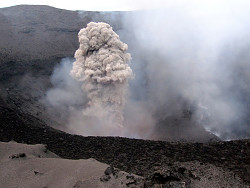 |
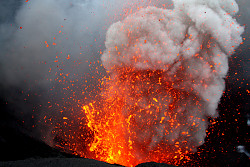 |
Amanda taught sail design and provisioning and before we knew it, it was time to pack sturdy shoes, warm clothes and water and head up to the village. Marilouise, one of the village women opened up the handicrafts market for us to check out and we donated more supplies to the village school.
Surprisingly, right at 4PM, the truck showed up, we paid Stanley 1500 vatu each (US$16) and we were off with our driver Rosen. The roads, normally abysmal, were badly eroded in places from the last few days of steady rains. The dual cab diesel Toyota 4WD was amazing – packed with a total of 10 people in the cab and back. Rosen slowly and skillfully climbed the washed out roads and we arrived at the base of the crater nearly an hour before sunset.
Mt Yasur was in amazing form; every few minutes we would feel the concussive shock of an explosion and then get to view the fireworks -Â molten blobs of lava the size of Volkswagens being hurled a thousand feet in the air amid mushroom shaped clouds, only to make strange splat-splat-splat sounds as they landed in the crater rim. As the sun set, the show became even more spectacular. We were the last ones left on the mountain and when Rosen suggested it was just about to start tipping again we reluctantly took it as our cue to head back down the mountain. Thankfully Amanda, who was under the weather with the flu, had an amazing dinner waiting when we arrived back aboard MT at 1930.
Weather charts and GRIB files showed that a high was blocking the normal easterly movement of a trough that had perched over Vanuatu and we again had another very unusual night of blinding rains and winds gusting to 30kts. Fortunately after arrival Roger had not only snorkeled down to check the anchor he had even videotaped our 75 lb CQR totally buried to the shackle.
Yesterday morning before departure to the island of Erromango (http://en.wikipedia.org/wiki/Erromango) Bill, Roger and I went ashore to thank Stanley and Johnson for arranging the truck and to deliver toothbrushes for all of the village children. We didn’t give Robert and Lesley (and Bill who volunteered to sail with them) as much of a head start this time but it still took us several hours to catch them with full main and only one reef in the poled out genoa. Several of our gang hit 10’s and 11’s on the GPS speed but Roger’s earlier record of 12.4 kts still stands. The 25-35 kt winds and drizzle were unabated until we rounded the Uvwore Point.
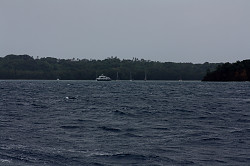 Leaving Port Resolution Leaving Port Resolution |
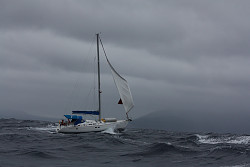 Gracias charging along Gracias charging along |
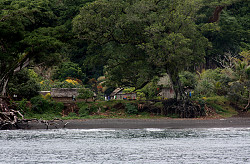 Port Navrin Village Port Navrin Village |
In Port Narvin on the east side of Erromango we found winds of only 15-20 kts and some swell wrapping around but all n all a safe anchorage. We had planned to sail again to Dillon’s Bay on the W side of the Island but upon reading about Port Narvin in Richard Cheshire’s Rocket Cruising Guide we had to check it out. The bay is described as fairly protected in SE tradewinds, rarely visited by yachts and as having a few hundred friendly inhabitants.
Friendly was an understatement. Even before we dropped the anchor, dozens of screaming kids were running the length of the beach, waving and jumping up and down. As soon as we’d launched the dinghy, I retrieved Bill and zipped through the surf where dozens of kids waded out to help pull the dingy up the black volcanic sand beach. Within minutes more than 70 villagers ambled up and I was introduced to Chief Joe and Mere; one of the teachers. I said that we were bringing school supplies and would like to learn what they needed for our visit next year and was told “You are most welcome ashore, come tomorrow at 10am and some of the children will sing for you”.
September 5, 2012, 2330 hrs, 18.30S S, 168.57 E, Log: 159,191 miles
Baro: 1020.0, Cabin Temp: 75 F cockpit 72 F, sea water 77 F
Broad reaching at 6.5 kts in 20 kt SE trades, double-reefed main and genoa, moonlit seas
MOONLIT SILVER SEAS
We’ve now set sail from Erromango Island for our final Leg 5 destination, Port Vila, the capital of Vanuatu on Efate Island. What a jam-packed day we’ve had!
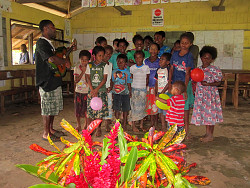  |
After breakfast we covered anchoring class then headed ashore where more than 50 adults and kids were waiting on the beach. Chief Joe walked us to the school where teachers Mere, Mary and Don invited us in and asked us to sit down. Mere, the shy headmistress, said we were the first visitors to the school and she hoped we would enjoy the singing.
Her husband played the guitar and led the children in songs about their schools and community. She asked each of us to stand and introduce ourselves then after another couple songs we visited for awhile. We learned that Potnarvin has no road access, only receives a freighter every three months or so, and that it is a 4-5 hour skiff ride to reach distant Dillons Bay on the far western side of the island.
Mere accepted the school supplies we’d donated and agreed to give us a list of additional supplies they need. We will email Beth and Norm on Sarah Jean and ask them to purchase supplies before departing Fiji. Mr. Don and Daniel, the volunteer nurse, led us through the sizable and tidy village to the tiny clinic. We didn’t have any medical supplies to donate but several sets of sheets, left by earlier expedition members, were very much appreciated.
Roger explains surfing
Upon setting sail and clearing the bay we were quickly surfing north in gusts to 35 as we skirted along the coast of Erromango to reach Ponamlas Bay; a tiny bay on the furthest NW corner of the island mentioned in Rocket Cruising Guide. The dramatic bay looked idyllic and was completely sheltered from the gusty winds and swell occurring just outside. In no time we’d launched the dinghy, collected Robert and Lesley and all headed ashore for a hike.
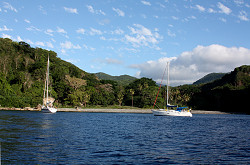 |
From the boat we’d spied fence posts and a roof and ashore we found the framework of a thatch house, a small abandoned frame house, lemon and orange trees, and many cleared areas with evidence of wild cows. We hiked up a trail that ran along the river and soon after Roger and I crossed over the river, in search of a trail back to the beach on the other side, we heard dogs and then human voices. Out of the woods appeared two very strong looking Ni-Vanutu guys with large bush knives and ten hunting dogs.
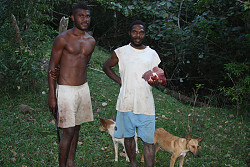 |
Robbie and his brother in law Allen had just hiked about 15 miles barefoot to come and check on their family’s property. Ronnie explained that their family had moved to Dillon’s Bay several years ago, but that they occasionally came to hunt the now-wild cattle. They said they stay for a couple days, eat all the meat they can and then hike back home. Allen hiked back to their house, returning with a large bag of just-butchered beef and then both guys walked back to the dinghy with us.
Following dinner Susana plotted our course and put the waypoints in the GPS before we all turned in for a little nap awakening at 2200 to set sail for Port Vila. We have clear skies, around half a brilliant moon and life is good!
September 7, 2012, 2230 hrs, 17.44S S, 168.18 E, Log: 159,258 miles
Stern-tied, Yachting World dock, Port Vila
A PERFECT ENDING TO AN AMAZING EXPEDITION!
Our landfall timing at Efate Island (http://en.wikipedia.org/wiki/Efate) went well, and it was 0930 by the time we had picked up a bow mooring line and backed in to stern-tie to the concrete wharf at Yachting World (http://yachtingworld-vanuatu.com). Almost immediately Amanda was showing our very keen crew how to strip, clean and lubricate winches and while Robert and I went to clear in with customs and immigration, Amanda had everyone take turns going aloft for rig inspection.
After crew enjoyed lunch just steps away ashore at the Waterfront Restaurant, Amanda taught sail repair and I covered diesel engine maintenance, watermakers, and dealing with customs worldwide leaving only storm tactics to cover in the morning.
Graduation dinner was at the elegant private Iririki Island Resort, (www.iririki.com/) formerly home of the British High Commissioner, and now a private resort with its own little ferry and an unbeatable view of the yachts and Port Vila waterfront.
Wow, what a whirlwind these last ten days have been and our crew left as firm friends eager to share explorations around the island and future sailing adventures. Amanda and I look forward to enjoying Efate with a sojourn anchored off Mele Beach to work on MT in between morning runs, kayaking and visits ashore with Bob and Lesley.
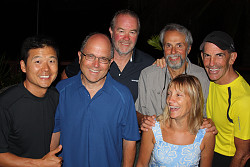 Here they are, our amazing Leg 5 crew: Roger, Joe, Bill, Raul, Susana & Dave Here they are, our amazing Leg 5 crew: Roger, Joe, Bill, Raul, Susana & Dave |
Roger, 36 from Portland, OR
I’ve dreamed of sailing the South Pacific since reading “Dove” by Robin Lee Graham, so when I was accepted for this expedition, it was a dream come true. I come on this trip to see new cultures and gain blue water sailing experience. I live in Portland, Oregon where I practice medicine and enjoy sailing on the Columbia River and surfing on the Oregon coast.
Joe, 54 from El Dorado, CA (east of Sacramento)
My wife Carla and I sail an O’Day 23 on Folsom Lake and look forward to getting a bigger boat and cruising the Caribbean and South Pacific in the future. I’ve sailed since I was 14 and we’ve chartered several times in the Caribbean.
Bill, 64 from North Bend (east of Seattle, WA)
I grew up sailing and surfing in Southern California but was transferred to the Seattle area about 15 years ago. Recently my wife and I purchased a Tashiba 36 which we are in the process of updating and improving.
Raul, 57 originally from Argentina, now living in Calgary, Canada
I grew up living near the water and racing dinghies in Buenos Aires and 25 years ago, Susana and I moved to Canada and started our family. We started sailing the coast of British Columbia to get our kids interested in sailing. We learned tons on this expedition, had fun, worked hard, met great people and feel more confident and prepared to fulfill our own sailing dreams.
Susana, 54
We always lived close to the water wishing to go cruising some day. Now the wish is to come back to these islands aboard our own HR 53 which we moor in Victoria, BC.
Dave, 57 from Phoenix, Arizona
I own a consulting business and my sailing experience is mostly lake sailing with limited offshore experience. I want to increase my confidence and skills in sailing offshore and in heavy weather so I’m better prepared for chartering boats in far away places.
Click HERE for a list of the anchorage updates from Leg 5 now posted on www.noonsite.com.
If you’re sailing to these islands on your own boat, or if you’re joining us on Leg 5-2013, here is a list of school supplies requested by Mere in Port Narvin, identical to supplies needed at nearly all schools in isolated areas: Blank exercise books, pencils, sharpeners, pens, crayons, coloured pencils, chaulk, scissors, educational posters, lesson books of any type, dictionaries, reading books, coloured construction paper, tape, paper glue, etc.

